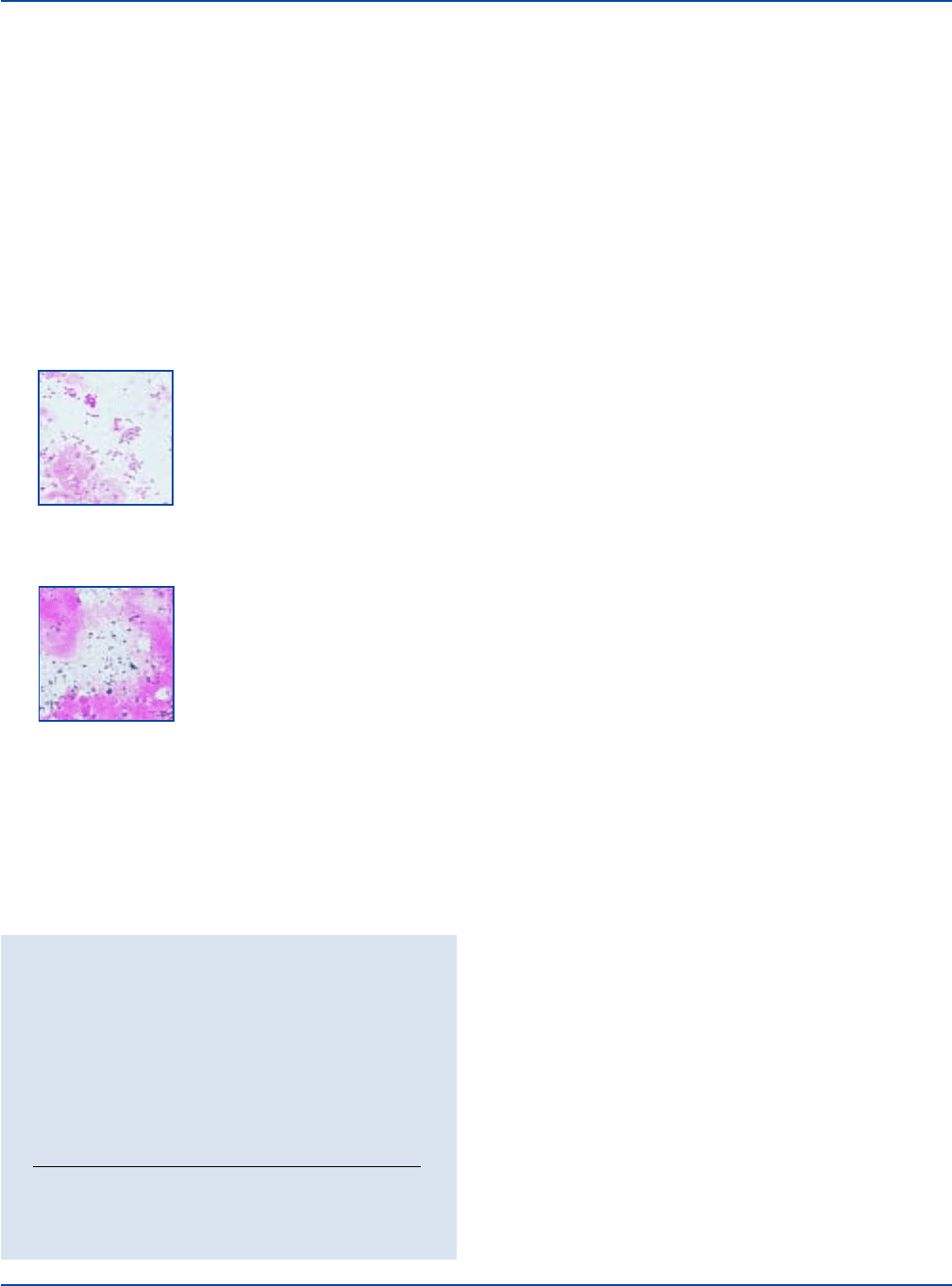BD Diagnostic Systems (publ.). Difco Manual (Manual of Microbiological Culture)
Подождите немного. Документ загружается.


The Difco Manual 599
Section IV Gram Stain Sets and Reagents
User Quality Control
Run controls daily using 18-24 hour cultures of known gram-
positive and gram-negative microorganisms. It is very important
that controls be included in each staining run, preferably on the
same slide. When performing the Gram stain on a clinical
specimen, particularly when the results will be used as a guide
to the selection of a therapeutic agent, such a control system
furnishes assurance that the iodine solution is providing proper
mordant activity and that decolorization was performed properly.
ORGANISM* ATCC
®
EXPECTED RESULTS
Staphylococcus aureus 25923 gram-positive cocci
Escherichia coli 25922 gram-negative rods
* Available as Bactrol™ Disks.
to characterize them, and the therapy to initiate while awaiting test
results.
Principles of the Procedure
The Gram stain procedure consists of
4,5,6
:
1. Staining a fixed smear with crystal violet;
2. Applying iodine as a mordant;
3. Decolorizing the primary stain with alcohol/acetone; and,
4. Counterstaining with safranin or basic fuchsin.
A crystal violet-iodine complex forms in the protoplast (not the cell
wall) of all organisms stained by this procedure. Organisms able to
retain this dye complex after decolorization are classified as
gram-positive while those that can be decolorized and
counterstained are classified as gram-negative.
2,4,5,6
Generally, the cell wall is nonselectively permeable. It is theorized that
during the Gram stain procedure, the cell wall of gram-positive cells
is dehydrated by the alcohol in the decolorizer and loses permeability,
thus retaining the primary stain. However, the cell wall of
gram-negative cells has a higher lipid content and becomes more
permeable when treated with alcohol, resulting in loss of the primary stain.
The principles of the 3-Step Gram Stain procedure are identical to
the 4-step procedure described above. However, the decolorizing and
counterstaining steps have been combined into one reagent.
The molecular basis for the Gram stain has not yet been determined.
Formula
Reagents are provided in two sizes, a 250 ml plastic dispensing bottle
with a dropper cap and a one-gallon container with a dispensing tap.
Standardization may include adjustment to meet performance
specifications.
3329-Gram Crystal Violet
PRIMARY STAIN
Aqueous solution of Crystal Violet.
3331-Gram Iodine
MORDANT
(Working solution prepared from Gram Diluent and Gram Iodine 100X)
Iodine Crystals . . . . . . . . . . . . . . . . . . . . . . . . . . . . . . . . . . 3.3 g
Potassium Iodide. . . . . . . . . . . . . . . . . . . . . . . . . . . . . . . . . 6.6 g
Distilled Water . . . . . . . . . . . . . . . . . . . . . . . . . . . . . . . . . . . 1 liter
3342-Stabilized Gram Iodine
MORDANT
Polyvinylpyrrolidone-Iodine Complex . . . . . . . . . . . . . . 100 g
Potassium Iodide. . . . . . . . . . . . . . . . . . . . . . . . . . . . . . . . . 19 g
Distilled Water . . . . . . . . . . . . . . . . . . . . . . . . . . . . . . . . . . . 1 liter
3330-Gram Decolorizer
DECOLORIZER
Acetone . . . . . . . . . . . . . . . . . . . . . . . . . . . . . . . . . . . . . . . 250 ml
Isopropanol . . . . . . . . . . . . . . . . . . . . . . . . . . . . . . . . . . . . 750 ml
3332-Gram Safranin
COUNTERSTAIN
Safranin O Powder (pure dye) . . . . . . . . . . . . . . . . . . . . . . . 4 g
Denatured Alcohol . . . . . . . . . . . . . . . . . . . . . . . . . . . . . . 200 ml
Distilled Water . . . . . . . . . . . . . . . . . . . . . . . . . . . . . . . . . 800 ml
3343-Gram Basic Fuchsin
COUNTERSTAIN
Basic Fuchsin . . . . . . . . . . . . . . . . . . . . . . . . . . . . . . . . . . 0.08 g
Phenol . . . . . . . . . . . . . . . . . . . . . . . . . . . . . . . . . . . . . . . . . 2.6 g
Isopropyl Alcohol . . . . . . . . . . . . . . . . . . . . . . . . . . . . . . . . 4.5 ml
Distilled Water . . . . . . . . . . . . . . . . . . . . . . . . . . . . . . . . . 993 ml
3335-3-Step Gram Safranin-S
DECOLORIZER/COUNTERSTAIN
Alcohol-based solution of safranin.*
3341-3-Step Gram Safranin-T
DECOLORIZER/COUNTERSTAIN
Alcohol-based solution of safranin.*
* Patent Pending
Positive Blood Culture Bottle
Specimen containing numerous
gram-negative rods with shape and
size of enteric rods. The culture
grew
Klebsiella pneumoniae.
Ground Beef
Sample containing
E. coli
: H7
and
Staphylococcus aureus.
Upon disruption or removal of the cell wall, the protoplast of
gram-positive (as well as gram-negative) cells can be decolorized and
the gram-positive attribute lost. Thus, the mechanism of the Gram
stain appears to be related to the presence of an intact cell wall able to
act as a barrier to decolorization of the primary stain.

600 The Difco Manual
Gram Stain Sets and Reagents Section IV
Precautions
1. For In Vitro Diagnostic Use.
2. 3329-Gram Crystal Violet
IRRITATING TO EYES, RESPIRATORY SYSTEM AND SKIN.
POSSIBLE RISK OF IRREVERSIBLE EFFECTS.
US
Avoid
contact with skin and eyes. Do not breathe spray. Wear suitable
protective clothing. Keep container tightly closed.
3331-Gram Iodine 100X
HARMFUL BY INHALATION, IN CONTACT WITH SKIN AND
IF SWALLOWED. MAY CAUSE HARM TO THE UNBORN
CHILD. Avoid contact with skin and eyes. Do not breathe fumes.
Wear suitable protective clothing. Keep container tightly closed.
3342-Stabilized Gram Iodine
HARMFUL IN CONTACT WITH SKIN. IRRITATING TO EYES,
RESPIRATORY SYSTEM AND SKIN. POSSIBLE RISK OF
HARM TO THE UNBORN CHILD.
US
Avoid contact with skin and
eyes. Do not breathe fumes. Wear suitable protective clothing. Keep
container tightly closed.
3330 - Bacto Gram Decolorizer
HIGHLY FLAMMABLE. IRRITATING TO EYES, RESPIRA-
TORY SYSTEM AND SKIN. Avoid contact with skin and eyes.
Do not breathe mist or vapor. Wear suitable protective clothing.
Keep container tightly closed. Keep away from sources of ignition.
No smoking.
3332 - Bacto Gram Safranin
FLAMMABLE.
EC
HARMFUL BY INHALATION AND IF
SWALLOWED. IRRITATING TO EYES, RESPIRATORY
SYSTEM AND SKIN. POSSIBLE RISK OF IRREVERSIBLE
EFFECTS.
US
Avoid contact with skin and eyes. Do not breathe
vapor. Wear suitable protective clothing. Keep container tightly
closed.
3335 - Bacto 3-Step Gram Safranin-S
HIGHLY FLAMMABLE. HARMFUL BY INHALATION AND
IF SWALLOWED. IRRITATING TO EYES, RESPIRATORY
SYSTEM AND SKIN. POSSIBLE RISK OF IRREVERSIBLE
EFFECTS.
US
POSSIBLE RISK OF HARM TO THE UNBORN
CHILD.
US
Avoid contact with skin and eyes. Do not breathe mist.
Wear suitable protective clothing. Keep container tightly closed.
Keep away from sources of ignition. No smoking.
3341 - Bacto 3-Step Gram Safranin-T
HIGHLY FLAMMABLE. HARMFUL BY INHALATION,
IN CONTACT WITH SKIN AND IF SWALLOWED. IRRITATING
TO EYES, RESPIRATORY SYSTEM AND SKIN. POSSIBLE
RISK OF IRREVERSIBLE EFFECTS.
US
POSSIBLE RISK
OF HARM TO THE UNBORN CHILD.
US
Avoid contact with
skin and eyes. Do not breathe mist. Wear suitable protective
clothing. Keep container tightly closed. Keep away from sources
of ignition. No smoking.
FIRST AID:
In case of contact with eyes, rinse immediately with plenty of
water and seek medical advice.
Gram Iodine 100X: Take off immediately all contaminated clothing.
After contact with skin, wash immediately with plenty of water.
If inhaled, remove to fresh air. If not breathing, give artificial
respiration. If breathing is difficult, give oxygen. Seek medical
advice.
If swallowed seek medical advice immediately and show this
container or label.
3. Studies demonstrate that the traditional Gram Iodine working
solution (Gram Iodine 100X dissolved in Gram Diluent) is
relatively unstable and may cause variability in the Gram stain
when sufficient iodine is no longer available to the solution.
Protect the iodine solution from undue exposure to air and heat.
Include controls in all staining runs or at least once daily (see
USER QUALITY CONTROL) to ensure that the solution is
providing proper mordant activity.
Storage
Store Gram Stain reagents at 15-30°C.
Expiration Date
The expiration date applies to the product in its intact container when
stored as directed.
Use the traditional Gram Iodine working solution within three months
of preparation, not exceeding the Expiry of either component.
Specimen Collection and Preparation
1. Apply the test specimen to a clean glass slide in a manner that will
yield a thin, uniform smear. Emulsify colonies from an 18-24 hour
culture in saline to obtain the proper density.
2. Allow the smear to air dry.
3. Fix the smear to the slide using one of the following techniques:
A. Heat fix by passing the slide through a low flame 2-3 times.
Cool the slide to room temperature before staining. NOTE: Do not
overheat the slide; excessive heating will cause atypical staining.
B. Methanol fix
6,7
the slide by flooding with absolute methanol
for 1-2 minutes and rinse with tap water before staining. NOTE:
For proper fixation, store absolute methanol in a brown screw-
capped bottle and replenish the working supply every two weeks.
Reagent Preparation
Prepare the traditional Gram Iodine working solution by adding an
entire 2.5 ml ampule of Gram Iodine 100X to 250 ml Gram Diluent or
an entire 40 ml vial of Gram Iodine 100X to 1 gallon of Gram Diluent;
mix thoroughly.
4-Step Staining Procedure
4
Materials Provided
4-Step Technique
Gram Crystal Violet
Gram Iodine or Bacto Stabilized Gram Iodine
Gram Decolorizer
Gram Safranin or Bacto Gram Basic Fuchsin
Materials Required but not Provided
Microscope slides
Bunsen burner or methanol
Bacteriological loop

The Difco Manual 601
Section IV Gram Stain Sets and Reagents
Swabs
Blotting paper
Microscope with oil immersion lens
Bactrol™ Gram Slide
Bactrol™ Disks
1. Flood the fixed smear with primary stain (Gram Crystal Violet) and
stain for 1 minute.
2. Remove the primary stain by gently washing with cold tap water.
3. Flood the slide with mordant (either Gram Iodine or Stabilized Gram
Iodine) and retain on the slide for 1 minute.
4. Remove the mordant by gently washing with tap water.
5. Decolorize (Gram Decolorizer) until solvent running from the slide
is colorless (30-60 seconds).
6. Wash the slide gently in cold tap water.
7. Flood the slide with counterstain (either Gram Safranin or Gram
Basic Fuchsin) and stain for 30-60 seconds.
8. Wash the slide with cold tap water.
9. Blot with blotting paper or paper towel or allow to air dry.
10. Examine the smear under an oil immersion lens.
3-Step Staining Procedure
Materials Provided
3-Step Stabilized Iodine Technique
Gram Crystal Violet
Stabilized Gram Iodine
3-Step Gram Safranin-S
3-Step Traditional Iodine Technique
Gram Crystal Violet
Gram Iodine
3-Step Gram Safranin-T
Materials Required but not Provided
Microscope slides
Bunsen burner or methanol
Bacteriological loop
Swabs
Blotting paper
Microscope with oil immersion lens
Bactrol™ Gram Slide
Bactrol™ Disks
1. Flood the fixed smear with primary stain (Gram Crystal Violet)
and stain for 1 minute.
2. Remove the primary stain by gently washing with cold tap water.
3. Flood the slide with mordant (Stabilized Gram Iodine or Gram
Iodine [traditional formulation]) and retain on the slide for 1 minute.
(Refer to LIMITATIONS OF THE PROCEDURE, #5.)
4. Wash off the mordant with decolorizer/counterstain (3-Step Gram
Safranin-S or 3-Step Gram Safranin-T). (NOTE: Do not wash off
iodine with water.) Add more decolorizer/counterstain solution to
the slide and stain 20-50 seconds.
5. Remove the decolorizer/counterstain solution by gently washing
the slide with cold tap water.
6. Blot with blotting paper or paper towel or allow to air dry.
7. Examine the smear under an oil immersion lens.
Results
4-STEP 4-STEP 3-STEP TECHNIQUE
TECHNIQUE TECHNIQUE USING EITHER
USING USING GRAM SAFRANIN-S
REACTION GRAM SAFRANIN BASIC FUCHSIN OR GRAM SAFRANIN-T
Gram-positive Purple-black Bright purple to Purple-black
cells purple-black cells to purple cells
Gram-negative Pink to red Bright pink to Red-pink to
cells fuchsia cells fuchsia cells
Limitations of the Procedure
1. The Gram stain provides preliminary identification information
only and is not a substitute for cultural studies of the specimen.
2. Prior treatment with antibacterial drugs may cause gram-positive
organisms from a specimen to appear gram-negative.
3. Use of an 18-24 hour culture is advisable for best results since
fresh cells have a greater affinity than old cells for most dyes. This
is particularly true of many spore formers, which are strongly
gram-positive when examined in fresh cultures but which later
become gram-variable or gram-negative.
4. The Gram stain reaction, like the acid-fast reaction, is altered by
physical disruption of the bacterial cell wall or protoplast. The cell
walls of gram-positive bacteria interpose a barrier which prevents
leaching of the dye complex from the cytoplasm. Cell walls of
gram-negative bacteria contain lipids soluble in organic solvents,
which are then free to decolorize the cytoplasm. Therefore, a
microorganism that is physically disrupted by excess heating will
not react to Gram staining as expected.
5. 3-Step Gram Safranin-S is intended for use with stabilized iodine.
3-Step Gram Safranin-T is intended for use with traditional iodine.
Unsatisfactory results may occur if other combinations of iodine
and 3-Step Gram Safranin are used.
6. Over time, a fine precipitate may develop in Gram Basic Fuchsin,
3-Step Gram Safranin-S and 3-Step Gram Safranin-T. Product
performance will not be affected.
References
1. Fortschr. Med., 1884, 2:185
2. Donnelly, J. P. 1962. The secrets of Gram’s stain. Infec. Dis. Alert.
15:109-112.
3. N.Y. Agr. Exp. Sta. Tech. Bull., 1923. 93.
4. Bartholomew, J. W. 1962. Variables influencing results, and the
precise definition of steps in gram staining as a means of
standardizing the results obtained. Stain Technol. 37:139-155.
5. Kruczak-Filipov, P., and R. G. Shively. 1992. Gram Stain
procedure, p. 1.5.1-1.5.18. In H.D. Isenberg (ed.), Clinical
Microbiology Procedures Handbook, vol. 1. American Society for
Microbiology, Washington, D.C.
6. Murray, P. R. (ed.). 1995. Manual of Clinical Microbiology, 6th
ed. American Society of Microbiology, Washington, D.C.
7. Mangels, J. I., M. E. Cox, and L. H. Lindley. 1984. Methanol
fixation. An alternative to heat-fixation of smear. Diag. Microbiol.
Infect. Dis. 2:129-137.

602 The Difco Manual
TB Stain Sets and Reagents Section IV
Packaging
Gram Crystal Violet 6 x 250 ml 3329-76
PRIMARY STAIN 1 gallon 3329-83
Gram Iodine 6 x 250 ml 3331-76
MORDANT 1 gallon 3331-83
Stabilized Gram Iodine 6 x 250 ml 3342-76
MORDANT 1 gallon 3342-83
Gram Decolorizer 6 x 250 ml 3330-76
DECOLORIZER 1 gallon 3330-83
Gram Safranin 6 x 250 ml 3332-76
COUNTERSTAIN 1 gallon 3332-83
Gram Basic Fuchsin 6 x 250 ml 3343-76
COUNTERSTAIN 1 gallon 3343-83
3-Step Gram Safranin-S 6 x 250 ml 3335-76
DECOLORIZER/COUNTERSTAIN 1 gallon 3335-83
3-Step Gram Safranin-T 6 x 250 ml 3341-76
DECOLORIZER/COUNTERSTAIN 1 gallon 3341-83
Gram Stain Set 4 x 250 ml 3328-32
Contents: Gram Crystal Violet 250 ml
Gram Iodine 250 ml
Gram Decolorizer 250 ml
Gram Safranin 250 ml
Gram Stain Set 4 x 250 ml 3338-32
(with Stabilized Iodine)
Contents: Gram Crystal Violet 250 ml
Stabilized Gram Iodine 250 ml
Gram Decolorizer 250 ml
Gram Safranin 250 ml
3-Step Gram Stain Set-S 3 x 250 ml 3334-3
Contents: Gram Crystal Violet 250 ml
Stabilized Gram Iodine 250 ml
3-Step Gram Safranin-S 250 ml
3-Step Gram Stain Set-T 3 x 250 ml 3337-32
Contents: Gram Crystal Violet 250 ml
Gram Iodine 250 ml
3-Step Gram Safranin-T 250 ml
Bactrol
™
Gram Slide 50 slides 3140-26
Bacto
®
TB Stain Sets and Reagents
TB Stain Set K
.
TB Stain Set ZN
.
TB Fluorescent Stain Set M
TB Fluorescent Stain Set T
Intended Use
Bacto TB Stain Sets are used to stain smears prepared from specimens
suspected of containing mycobacteria for early presumptive diagnosis
of mycobacterial infection.
Also Known As
TB Stain Set K is also known as the Kinyoun Stain.
TB Stain Set ZN is also known as the Ziehl-Neelsen Stain.
TB Fluorescent Stain Set M is also known as the Morse Stain.
TB Fluorescent Stain Set T is also known as the Truant Stain.
Summary and Explanation
The microscopic staining technique is one of the earliest methods
devised for detecting the tubercle bacillus and it remains a standard
procedure.
1-7
The unique acid-fast characteristic of mycobacteria makes
the staining technique valuable in early presumptive diagnosis, and
provides information about the number of acid-fast bacilli present.
Fluorescent microscopy offers many advantages over classic methods
for detecting mycobacteria because of its speed and simplicity, the ease
of examining the slide, and the reliability and superiority of the method.
8
TB Stain Set K uses the Kinyoun (cold) acid-fast procedure described
by Kinyoun.
4,9
TB Stain Set ZN uses the Ziehl-Neelsen (hot) acid-fast procedure
described by Kubica and Dye.
4,10
TB Fluorescent Stain Set M uses the auramine O acid-fast fluorescent
procedure described by Morse, Blair, Weiser and Sproat.
4,11
TB Fluorescent Stain Set T uses the acid-fast fluorescent procedure
described by Truant, Brett and Thomas.
4,12
Principles of the Procedure
The lipid content of the cell wall of acid fast bacilli makes staining
of these organisms difficult. In acid fast stains, the phenol allows
penetration of the primary stain, even after exposure to acid-alcohol
decolorizers. For an organism to be termed acid fast, it must resist
decolorizing by acid-alcohol. A counterstain is then used to emphasize
the stained organisms, so they may be easily seen microscopically.
When using Stain Set K, acid fast bacilli (AFB) appear red against a
green background if Brilliant Green K is used as the counterstain or
red against a blue background if Methylene Blue is the counterstain.
When using Stain Set ZN, AFB appear red against a blue background
because Methylene Blue is used as the counterstain.
When using Stain Set M, AFB have a bright yellow-green fluorescence.
When using Stain Set T, AFB have a reddish-orange fluorescence.
Formula
3326-TB Stain Set K
Formulas per Liter
3321-TB Carbolfuchsin KF
Basic Fuchsin . . . . . . . . . . . . . . . . . . . . . . . . . . . . . . . . . . . 15 g
Phenol USP . . . . . . . . . . . . . . . . . . . . . . . . . . . . . . . . . . . . . 45 g
Isopropanol . . . . . . . . . . . . . . . . . . . . . . . . . . . . . . . . . . . . 200 ml
Ethanol . . . . . . . . . . . . . . . . . . . . . . . . . . . . . . . . . . . . . . . . 50 ml
Distilled Water . . . . . . . . . . . . . . . . . . . . . . . . . . . . . . . . . 750 ml

The Difco Manual 603
Section IV TB Stain Sets and Reagents
User Quality Control
It is recommended that a positive and negative control slide, such as
Bactrol™ TB Slide, be included with each batch of slides stained with
acid fast stains.
Identity Specifications
3313-TB Carbolfuchsin ZN
Appearance: Reddish-purple suspension with no visible
precipitate.
3314-TB Decolorizer TM
Appearance: Colorless, clear suspension.
3315-TB Potassium Permanganate
Appearance: Purple solution.
3316-TB Auramine M
Appearance: Yellow suspension.
3317-TB Auramine-Rhodamine T
Appearance: Red, viscous solution.
3318-TB Decolorizer
Appearance: Colorless, clear solution.
3319-TB Methylene Blue
Appearance: Blue solution with no visible precipitation.
3321-TB Carbolfuchsin KF
Appearance: Reddish purple suspension.
3327-TB Brilliant Green
Appearance: Green solution.
Stain Value
Stain Bactrol™ TB Slides (3139) using the appropriate TB
stain procedure. Examine slides using a light or fluorescent
microscope at a total magnification of 1000X (oil immersion).
TB STAIN SET K TB STAIN SET K TB
USING TB USING TB STAIN
ORGANISM ATCC
®
BRILLIANT GREEN METHYLENE BLUE SET ZN
Positive Control
M. tuberculosis H37 Ra 25177 Dark pink Dark pink Dark pink
to red to red to red
Negative Control
S. aureus 25923 Green Blue Blue
K. pneumoniae 13883 Green Blue Blue
TB FLUORESCENT TB FLUORESCENT
ORGANISM ATCC
®
STAIN SET M STAIN SET T
Positive Control
M. tuberculosis H37 Ra 25177 Bright Reddish, orange
yellow-green fluorescence
fluorescence
Negative Control
S. aureus 25923 No fluorescence No florescence
K. pneumoniae 13883 No fluorescence No florescence
3318-TB Decolorizer
Hydrochloric Acid . . . . . . . . . . . . . . . . . . . . . . . . . . . . . . . 30 ml
Denatured Ethanol . . . . . . . . . . . . . . . . . . . . . . . . . . . . . . 970 ml
3327-TB Brilliant Green K
Brilliant Green . . . . . . . . . . . . . . . . . . . . . . . . . . . . . . . . . . . 2 g
Sodium Hydroxide . . . . . . . . . . . . . . . . . . . . . . . . . . . . . . 0.02 g
Distilled Water . . . . . . . . . . . . . . . . . . . . . . . . . . . . . . . . 1000 ml
3324-TB Stain Set ZN
Formulas per Liter
3313-TB Carbolfuchsin ZN
Basic Fuchsin . . . . . . . . . . . . . . . . . . . . . . . . . . . . . . . . . . . 1.7 g
Phenol USP . . . . . . . . . . . . . . . . . . . . . . . . . . . . . . . . . . . . . 50 g
Isopropanol . . . . . . . . . . . . . . . . . . . . . . . . . . . . . . . . . . . . . 95 ml
Distilled Water . . . . . . . . . . . . . . . . . . . . . . . . . . . . . . . . . 905 ml
3318-TB Decolorizer
Hydrochloric Acid . . . . . . . . . . . . . . . . . . . . . . . . . . . . . . . 30 ml
Denatured Ethanol . . . . . . . . . . . . . . . . . . . . . . . . . . . . . . 970 ml
3319-TB Methylene Blue
Methylene Blue USP . . . . . . . . . . . . . . . . . . . . . . . . . . . . . 2.4 g
Ethanol . . . . . . . . . . . . . . . . . . . . . . . . . . . . . . . . . . . . . . . 300 ml
Distilled Water . . . . . . . . . . . . . . . . . . . . . . . . . . . . . . . . . 700 ml
3323-TB Fluorescent Stain Set M
Formulas per Liter
3316-TB Auramine M
Auramine O. . . . . . . . . . . . . . . . . . . . . . . . . . . . . . . . . . . . . . 2 g
Phenol USP . . . . . . . . . . . . . . . . . . . . . . . . . . . . . . . . . . . . . . 4 g
Glycerine USP . . . . . . . . . . . . . . . . . . . . . . . . . . . . . . . . . 100 ml
Isopropanol . . . . . . . . . . . . . . . . . . . . . . . . . . . . . . . . . . . . 250 ml
Distilled Water . . . . . . . . . . . . . . . . . . . . . . . . . . . . . . . . . 650 ml
3314-TB Decolorizer TM
Hydrochloric Acid . . . . . . . . . . . . . . . . . . . . . . . . . . . . . . . . 5 ml
Isopropanol . . . . . . . . . . . . . . . . . . . . . . . . . . . . . . . . . . . . 700 ml
Distilled Water . . . . . . . . . . . . . . . . . . . . . . . . . . . . . . . . . 300 ml
3315-TB Potassium Permanganate
Potassium Permanganate . . . . . . . . . . . . . . . . . . . . . . . . . . . 5 g
Distilled Water . . . . . . . . . . . . . . . . . . . . . . . . . . . . . . . . 1000 ml
3325-TB Fluorescent Stain Set T
Formulas per Liter
3317-TB Auramine-Rhodamine T
Auramine O. . . . . . . . . . . . . . . . . . . . . . . . . . . . . . . . . . . . . 12 g
Rhodamine B . . . . . . . . . . . . . . . . . . . . . . . . . . . . . . . . . . . . 6 g
Phenol USP . . . . . . . . . . . . . . . . . . . . . . . . . . . . . . . . . . . . . 80 g
Glycerine USP . . . . . . . . . . . . . . . . . . . . . . . . . . . . . . . . . 600 ml
Isopropanol . . . . . . . . . . . . . . . . . . . . . . . . . . . . . . . . . . . . 140 ml
Distilled Water . . . . . . . . . . . . . . . . . . . . . . . . . . . . . . . . . 260 ml
3314-TB Decolorizer TM
Hydrochloric Acid . . . . . . . . . . . . . . . . . . . . . . . . . . . . . . . . 5 ml
Isopropanol . . . . . . . . . . . . . . . . . . . . . . . . . . . . . . . . . . . . 700 ml
Distilled Water . . . . . . . . . . . . . . . . . . . . . . . . . . . . . . . . . 300 ml
3315-TB Potassium Permanganate
Potassium Permanganate . . . . . . . . . . . . . . . . . . . . . . . . . . . 5 g
Distilled Water . . . . . . . . . . . . . . . . . . . . . . . . . . . . . . . . 1000 ml
Precautions
1. For In Vitro Diagnostic Use.
2. 3313-TB Carbolfuchsin ZN
IRRITATING TO EYES, RESPIRATORY SYSTEM AND SKIN.
TOXIC IN CONTACT WITH SKIN AND IF SWALLOWED.
EC
CAUSES BURNS.
EC
POSSIBLE RISK OF IRREVERSIBLE

604 The Difco Manual
EFFECTS.
EC
Avoid contact with skin and eyes. Do not breathe mist.
Wear suitable protective clothing. Keep container tightly closed.
3314-TB Decolorizer TM
HIGHLY FLAMMABLE. CAUSES BURNS. Avoid contact with
skin and eyes. Do not breathe mist. Wear suitable protective
clothing. Keep container tightly closed. Keep away from sources
of ignition. No smoking.
3315-TB Potassium Permanganate
IRRITATING TO EYES, RESPIRATORY SYSTEM AND SKIN.
Avoid contact with skin and eyes. Do not breathe mist. Wear suitable
protective clothing. Keep container tightly closed.
3316-TB Auramine M
FLAMMABLE. IRRITATING TO EYES, RESPIRATORY SYS-
TEM AND SKIN. POSSIBLE RISK OF IRREVERSIBLE
EFFECTS.
US
Avoid contact with skin and eyes. Do not breathe mist.
Wear suitable protective clothing. Keep container tightly closed.
Keep away from sources of ignition. No smoking.
3317-TB Auramine-Rhodamine T
FLAMMABLE. IRRITATING TO EYES, RESPIRATORY SYS-
TEM AND SKIN. TOXIC IN CONTACT WITH SKIN AND IF
SWALLOWED.
EC
CAUSES BURNS.
EC
POSSIBLE RISK OF
IRREVERSIBLE EFFECTS. Avoid contact with skin and eyes. Do
not breathe mist. Wear suitable protective clothing. Keep container
tightly closed. Keep away from sources of ignition. No smoking.
3318-TB Decolorizer
HIGHLY FLAMMABLE. HARMFUL BY INHALATION AND
IF SWALLOWED. IRRITATING TO EYES, RESPIRATORY
SYSTEM AND SKIN.
US
POSSIBLE RISK OF IRREVERSIBLE
EFFECTS.
US
POSSIBLE RISK OF HARM TO THE UNBORN
CHILD.
US
Avoid contact with skin and eyes. Do not breathe mist.
Wear suitable protective clothing. Keep container tightly closed.
Keep away from sources of ignition. No smoking.
3319-TB Methylene Blue
FLAMMABLE. IRRITATING TO EYES, RESPIRATORY SYS-
TEM AND SKIN. HARMFUL BY INHALATION AND IF
SWALLOWED. POSSIBLE RISK OF IRREVERSIBLE
EFFECTS.
US
Avoid contact with skin and eyes. Do not breathe
vapors. Wear suitable protective clothing. Keep container tightly
closed.
3321-TB Carbolfuchsin KF
FLAMMABLE. IRRITATING TO EYES, RESPIRATORY SYS-
TEM AND SKIN. HARMFUL BY INHALATION AND IF
SWALLOWED.
EC
POSSIBLE RISK OF IRREVERSIBLE
EFFECTS.
US
POSSIBLE RISK OF HARM TO THE UNBORN
CHILD.
US
Avoid contact with skin and eyes. Do not breathe mist.
Wear suitable protective clothing. Keep container tightly closed.
Keep away from sources of ignition. No smoking.
FIRST AID:
In case of contact with eyes, rinse immediately with plenty of
water and seek medical advice.
After contact with skin, wash immediately with plenty of water.
If inhaled, remove to fresh air. If not breathing, give artificial
respiration. If breathing is difficult, give oxygen. Seek medical
advice.
If swallowed seek medical advice immediately and show this
container or label.
Storage
Store TB Stain Sets and reagents at 15-30°C. Reagents that have been
removed from the packing carton should be stored in the dark.
Expiration Date
The expiration date applies to the product in its intact container when
stored as directed. Do not use a product if it fails to meet specifications
for identity and performance.
Procedure
Materials Provided
TB Stain Set K*
TB Stain Set ZN*
TB Fluorescent Stain Set M*
TB Fluorescent Stain Set T*
Bactrol
™
TB Slides
*Individual reagents available separately. See Packaging.
Materials Required but not Provided
Microscope slides–new or cleaned in acid dichromate solution
Staining rack
Microscope with oil immersion lens, OR
Fluorescent microscope
(See #8 of each fluorescent staining procedure for a complete
description of the appropriate assembly required.)
Specimen Collection and Preparation
1. Acid fast stains may be performed on any type of clinical specimen
suspected of containing mycobacteria.
4-5
Smears from sputum and
other respiratory tract secretions are usually made from concentrated
specimens. For procedures used in concentrating specimens for
acid fast bacilli, please consult appropriate references.
4-7
2. Apply a thin smear of the specimen directly on a clear microscope
slide.
3. Allow smear to air dry.
4. Fix the smear to the slide by passing the slide through a low flame
2-3 times, avoiding excessive heat.
Test Procedure
See appropriate references for specific procedures.
Kinyoun Stain
TB Stain Set K
1. Place slides on a staining rack and flood with TB Carbolfuchsin
KF for 4 minutes. Do not heat.
2 Wash gently in running water.
3. Decolorize with TB Decolorizer for 3-5 seconds, or until no more
red color appears in washing.
4. Wash gently in running water.
5. Counterstain with either TB Brilliant Green K or TB Methylene
Blue (available separately) for 30 seconds.
TB Stain Sets and Reagents Section IV

The Difco Manual 605
6. Wash gently in running water.
7. Air dry. If using TB Methylene Blue, dry over gentle heat.
Ziehl-Neelsen Stain
TB Stain Set ZN
1. Place slides on a staining rack and flood with TB Carbolfuchsin
ZN. Heat gently to steaming and allow to steam for 5 minutes.
2. Wash gently in running water.
3. Decolorize with TB Decolorizer for 3-5 seconds or until no more
red color appears in washing.
4. Wash gently in running water.
5. Counterstain with either TB Methylene Blue or TB Brilliant
Green K for 30 seconds.
6. Wash gently in running water.
7. Dry over gentle heat.
Morse Stain
Fluorescent Stain Set M
1. Place slides on a staining rack and flood with TB Auramine M for
15 minutes.
2. Wash gently in running water.
3. Decolorize with TB Decolorizer TM for 30-60 seconds.
4. Wash slides gently in running water.
5. Counterstain with TB Potassium Permanganate for 2 minutes.
6. Wash gently in running water.
7. Air dry.
8. Examine under a microscope fitted, as described by Morse et al.,
11
with an incandescent bulb, a KG 1 heat filter, a 3-4 mm thick BG
excitation filter, an ordinary substage condenser and a No. 51 bright
field or GG barrier filter.
Truant Stain
TB Fluorescent Stain Set T
1. Place slides on a staining rack and flood with TB Auramine-
Rhodamine T that has been thoroughly shaken prior to use. Leave
undisturbed for 20-25 minutes at room temperature.
2. Wash gently in running water.
3. Decolorize with TB Decolorizer TM for 2-3 minutes.
4. Wash gently in running tap water.
5. Counterstain with TB Potassium Permanganate for 4-5 minutes.
6. Wash gently in running water.
7. Blot lightly. Dry in air or very gently over a flame.
8. Examine under a microscope fitted, as described by Truant et al.,
13
with 25X objective, an HBO L2 bulb heat filter, a BG 12 primary
filter and OG 1 barrier filter.
Results
Refer to appropriate references and procedures for results.
Limitations of the Procedure
1. A positive staining reaction provides presumptive evidence of the
presence of M. tuberculosis in the specimen. A negative staining
reaction does not necessarily indicate that the specimen will be
culturally negative for M. tuberculosis. For positive identification
of M. tuberculosis, cultural methods must be employed.
2. Rapidly growing mycobacteria may retain acid-fast stains to a
varying degree. Most rapidly growing mycobacteria will not
fluoresce in fluorochrome-stained smears.
4
3. Organisms other than mycobacteria, such as Rhodococcus spp.,
Nocardia spp., Legionella micdadei, and the cysts of
Cryptosporidium spp. and Isospora spp., may display various
degrees of acid-fastness.
4
4. When decolorizing with acid-alcohol, avoid under-decolorization.
It is difficult to over-decolorize acid-fast organisms.
5. During the counterstaining step with potassium permanganate,
timing is critical. Quenching the fluorescing bacilli occurs when
counterstaining for a longer period of time.
4
6. If fluorochrome stained slides cannot be observed immediately,
they may be stored at 2-8°C in the dark for up to 24 hours. This is
required to prevent fading of the fluorescence.
4
7. Prolonged counterstaining in non-fluorochrome stains may mask
the presence of acid-fast bacilli. Use of brilliant green may help to
minimize this problem.
4
References
1. Ziehl, F. 1882. Zur Färbung des Tuberkelbacillus. Dtsch. Med.
Wochenschr. 8:451.
2. Neelsen, F. 1883. Ein Casuistischer Beitrag zur Lehre von der
Tuberkulose. Centralbl. Med. Wiss. 21:497-501.
3. National Tuberculosis Association. 1961. Diagnostic Standards
and Classification of Tuberculosis. National Tuberculosis Associa-
tion, New York, NY.
4. Master, R. N. 1992. Mycobacteriology, p. 3.0.1-3.16.4. In
Isenberg, H. D. (ed.), Clinical 2microbiology procedures handbook,
vol. 1. American Society for Microbiology, Washington, D.C.
5. Nolte, F. S., and B. Metchock. 1995. Mycobacterium, p. 400-437.
In P. R. Murray, E. J. Baron, M. A. Pfaller, F. C. Tenover, and R. H.
Yolken (eds.), Manual of clinical microbiology, 6th ed. American
Society for Microbiology, Washington, D.C.
6. Baron, E. J., L. R. Peterson, and S. M. Finegold. 1994. Bailey &
Scott’s diagnostic microbiology, 9th ed. Mosby-Year Book, Inc.,
St. Louis, MO.
7. Kent, P. T., and G. P. Kubica. 1985. Public Health
Mycobacteriology: a guide for the Level III laboratory, p. 57-68.
U.S. Department of Health and Human Services, Centers for
Disease Control, Atlanta, GA.
8. Taylor, R. D. 1966. Modification of the Brown and Brenn Gram
Stain for the differential staining of gram-positive and gram-
negative bacteria in tissue sections. Am. J. Clin. Pathol. 46:472-4.
9. Kinyoun, J. J. 1915. A note on Uhlenhuth’s method for sputum
examination for tubercle bacilli. Am. J. Pub. Health. 5:867-70.
10. Kubica, G. P., and W. E. Dye. 1967. Laboratory methods for
clinical and public health Mycobacteriology. U.S.P.H. Serv.
Publication No., 1547; Superintendent of Documents, U.S.
Government Printing Office, Washington, D.C.
11. Fitzsimmons General Hospital. 1968. Mycobact. Lab. Methods.
Rept. No. 17., May, 1968.
12. Truant, J. P., W. A. Brett, and W. Thomas. 1962. Fluorescence
microscopy of tubercle bacilli stained with auramine and
rhodamine. Bull. Henry Ford Hosp. 10:287-296.
Section IV TB Stain Sets and Reagents

606 The Difco Manual
13. Willis, H. S., and M. M. Cummings. 1952. Diagnostic and
Experimental Methods in Tuberculosis, 2nd ed. Charles C. Thomas,
Springfield, IL.
Packaging
TB Stain Set K 3 x 250 ml 3326-32
Contains:
TB Carbolfuchsin KF 250 ml
TB Decolorizer 250 ml
TB Brilliant Green K 250 ml
TB Stain Set ZN 3 x 250 ml 3324-32
Contains:
TB Carbolfuchsin ZN 250 ml
TB Decolorizer 250 ml
TB Methylene Blue 250 ml
TB Fluorescent Stain Set M 3 x 250 ml 3323-32
Contains:
TB Auramine M 250 ml
TB Decolorizer TM 250 ml
TB Potassium Permanganate 250 ml
TB Fluorescent Stain Set T 3 x 250 ml 3325-32
Contains:
TB Auramine-Rhodamine T 250 ml
TB Decolorizer TM 250 ml
TB Potassium Permanganate 250 ml
TB Auramine M 6 x 250 ml 3316-76
TB Auramine-Rhodamine T 6 x 250 ml 3317-76
TB Brilliant Green K 6 x 250 ml 3327-76
TB Carbolfuchsin KF 6 x 250 ml 3321-76
TB Carbolfuchsin ZN 6 x 250 ml 3313-76
TB Decolorizer 6 x 250 ml 3318-76
TB Decolorizer TM 6 x 250 ml 3314-76
TB Methylene Blue 6 x 250 ml 3319-76
TB Potassium Permanganate 6 x 250 ml 3315-76
Bactrol
™
TB Slides 50 slides 3139-26
TB Stain Sets and Reagents Section IV


The Difco Manual 609
Section V Bordetella Antigens and Antiserum
Bacto
®
Bordetella Antigens and Antiserum
Bordetella Pertussis Antiserum
.
Bordetella Parapertussis
Antiserum
.
Bordetella Pertussis Antigen
User Quality Control
Identity Specifications
Bordetella Pertussis Antiserum
Bordetella Parapertussis Antiserum
Lyophilized Appearance: Light gold to amber, button to
powdered cake.
Rehydrated Appearance: Light gold to amber, clear liquid.
Bordetella Pertussis Antigen
Appearance: Light gray to white suspension, may
settle upon standing.
Performance Response
Rehydrate Bordetella Pertussis and Parapertussis Antiserum
per label directions. Test as described (see Test Procedure).
Bordetella Pertussis Antigen or known positive and negative
control cultures must give appropriate reactions.
Intended Use
Bacto Bordetella Pertussis Antiserum and Bacto Bordetella
Parapertussis Antiserum are used in the slide agglutination test for
identifying Bordetella pertussis and Bordetella parapertussis.
Bacto Bordetella Pertussis Antigen is used to demonstrate a positive
quality control test in the slide agglutination test.
Summary and Explanation
All members of the genus Bordetella are respiratory pathogens of
warm-blooded animals. Two species, B. pertussis and B. parapertussis,
are uniquely human pathogens. These organisms adhere to, multiply
among and remain localized in the ciliated epithelial cells of the
respiratory tract. B. pertussis is the major cause of whooping cough or
pertussis. B. parapertussis is associated with a milder, less frequently
occurring form of the disease.
1
Person-to-person transmission occurs
by the aerosol route. Pertussis is a highly contagious disease that, more
than 90% of the time, attacks unimmunized populations.
2
Toxin
production remains the major distinction between B. pertussis and
B. parapertussis.
Classic pertussis caused by B. pertussis occurs in three stages. The
first (catarrhal) stage is characterized by nonspecific symptoms similar
to a cold or viral infection. The disease is highly communicable during
this stage, which lasts 1-2 weeks. During the second (paroxysmal)
stage, the cough increases in intensity and frequency. This stage
is marked by sudden attacks of severe, repetitive coughing, often
culminating with the characteristic whoop. The whooping sound is
caused by the rapid inspiration of air after the clearance of mucus-
blocked airways.
3
This stage may last 1-4 weeks. The beginning of the
convalescent stage is marked by a reduction in frequency and severity
of coughing spells. Complete recovery may require weeks or months.
Despite the availability of an effective whole-cell vaccine, pertussis
remains a disease of worldwide distribution because many developing
nations do not have the resources for vaccinating their populations.
4
Major outbreaks have occurred even in developed nations such as Great
Britain and Sweden. Pertussis is endemic in the United States, with
most disease occurring as isolated cases. There has been a shift in the
age group affected by the disease. In the past, children in the 1-5 year
age group were more prone to pertussis. Since adults do not receive
booster vaccinations, children less than one year of age
2
have become
more susceptible because of a decrease in passively transferred maternal
antibodies.
Bordetella are tiny, gram-negative, strictly aerobic coccobacilli that
occur singly or in pairs and may exhibit a bipolar appearance. While
some species are motile, B. pertussis and B. parapertussis are nonmotile.
They do not produce acid from carbohydrates. B. pertussis will not
grow on common blood agar bases or chocolate agar, while
B. parapertussis will grow on blood agar and sometimes on chocolate
agar. Media for primary isolation must include starch, charcoal, ion-
exchange resins or a high percentage of blood to inactivate inhibitory
substances.
3
B. pertussis may be recovered from secretions collected
from the posterior nasopharynx, bronchoalveolar lavage and
transbronchial specimens.
Principles of the Procedure
Identification of Bordetella species includes isolation of the microor-
ganisms, biochemical identification and serological confirmation.
Serological confirmation involves the reaction in which the microor-
ganism (antigen) reacts with its corresponding antibody. The in vitro
reaction produces macroscopic clumping called agglutination. The
desired homologous reaction is rapid, does not dissociate (has high
avidity), and binds strongly (has high affinity).
Because a microorganism (antigen) may agglutinate with an antibody
produced in response to some other species, heterologous reactions
are possible. These are weak in strength or slow in formation. Such
unexpected and, perhaps, unpredictable reactions may lead to some
confusion in serological identification. Therefore, a positive homologous
agglutination reaction should support the morphological and biochemical
identification of the microorganism.
Homologous reactions are rapid and strong. Heterologous reactions
are slow and weak.
Reagents
Bordetella Pertussis and Parapertussis Antisera are lyophilized,
polyclonal rabbit antiglobulins containing approximately 0.04%
Thimerosal as a preservative. When rehydrated and used as described,
each 1 ml vial of Bordetella Pertussis or Parapertussis Antiserum
diluted 1:10 contains sufficient reagent for 200 slide tests.
